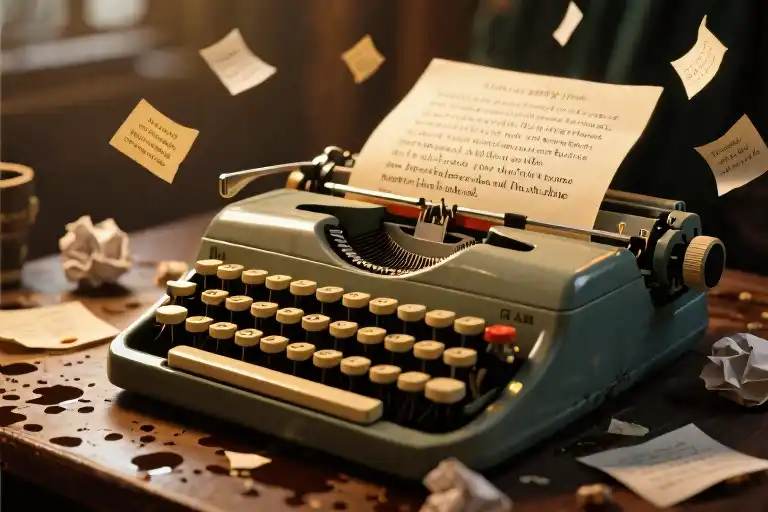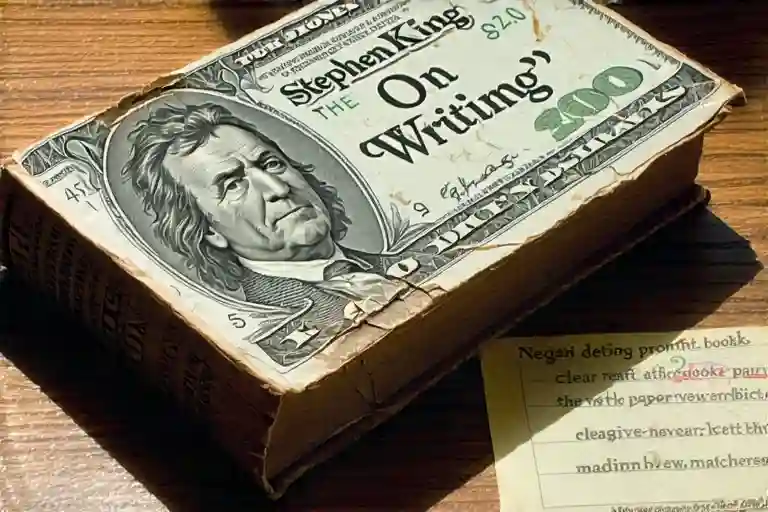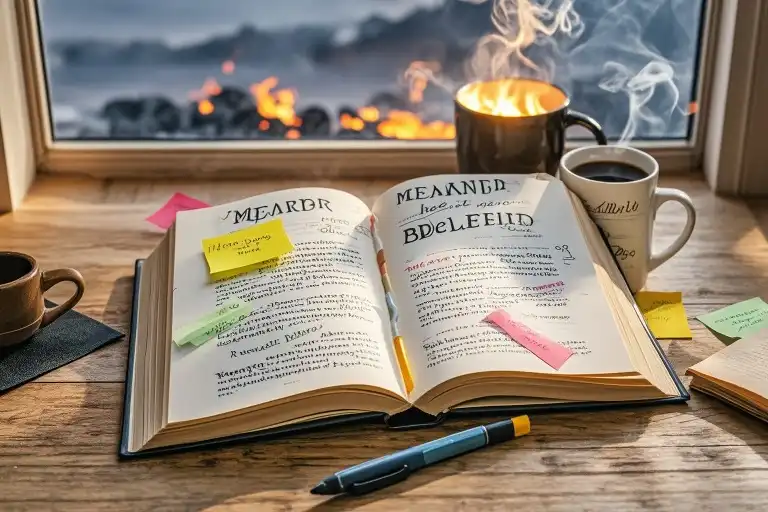“I wish I could write like them!”
That desperate whisper lives in every beginner’s mind. The same awe that makes us bookmark paragraphs, screenshot sentences, and sigh over turns of phrase we’d never conceive. According to a 2023 writing community survey, 92% of emerging writers admit experiencing paralyzing comparison anxiety when reading accomplished authors.
What transforms these “How do they do this?” moments from creative roadblocks into stepping stones? The answer hides in plain sight: those breathtaking passages aren’t magic—they’re mastered craftsmanship. The difference between admiration and achievement lies not in innate talent, but in learning to reverse-engineer brilliance.
Consider this—the sentences that make your fingers hesitate over the keyboard share three universal traits:
- Precision of observation (noticing what others overlook)
- Deliberate rhythm (orchestrating pauses and accelerations)
- Emotional residue (lingering effects beyond literal meaning)
When Virginia Woolf describes a London morning as “the air tasted of soot and daffodils,” she’s not just reporting weather. That sensory juxtaposition—grime against spring—mirrors the city’s contradictions. This is what separates generic description from evocative writing: the ability to layer multiple truths into single phrases.
The transition from passive reader to active writer begins when we shift our focus:
- Instead of “Why can’t I do this?” ask “What exact techniques create this effect?”
- Rather than coveting someone’s voice, dissect how they develop writing style through consistent word choices
- Replace overwhelm with curiosity by isolating one skill at a time (dialogue? metaphor? pacing?)
That tightness in your chest when reading extraordinary prose? That’s not inadequacy—it’s your writing instincts recognizing excellence. Now comes the quiet work of understanding why.
From Awe to Understanding: The Cognitive Leap in Writing Growth
That moment when you read a passage so perfectly crafted it makes your fingertips tingle—we’ve all been there. The whispered “How do they do this?” that follows isn’t just envy, it’s the first spark of a writer’s awakening. What separates perpetual admirers from evolving writers isn’t some mystical gift, but a deliberate shift in how we engage with words.
The Four Stages of Writer Development
- Mimicry Phase: Copying sentence structures like tracing paper over favorite poems. You’ll find young J.K. Rowling’s early Harry Potter drafts filled with lifted phrases from Jane Austen until she found her rhythm.
- Digestion Phase: Highlighting not just beautiful lines, but why they work—noticing how Murakami uses mundane details (boiling pasta, changing records) to ground surreal scenes.
- Innovation Phase: Writing exercises where you recreate Hemingway’s iceberg theory using your childhood memories.
- Signature Phase: When your rejected manuscript pages start getting framed by readers instead of recycled.
The transition happens when we stop asking “What makes their writing good?” and start investigating “How did they make me feel this?” That’s when bookstore visits transform into forensic labs.
Case Study: The Sorcerer’s Stone vs. The Philosopher’s Stone
Compare these two openings from Rowling’s early draft versus the published version:
- 1995 Draft: “The hottest day of the summer so far was drawing to a close…” (Standard weather opening)
- Final Version: “Mr. and Mrs. Dursley, of number four, Privet Drive, were proud to say they were perfectly normal…” (Immediate character judgment)
The magic isn’t in fancier vocabulary—it’s in choosing to reveal human nature rather than meteorology. This shift from passive description to active characterization marks the professional leap.
Observation vs. Reading: The Mindset Divide
Passive reading consumes words like movie popcorn. Active observation:
- Counts how many sensory details appear per paragraph
- Notices when complex ideas get expressed through simple nouns
- Flags sentences where punctuation alters emotional tempo
Try this tonight: Re-read your favorite book’s first chapter with a blue pencil. Circle every verb. You’ll discover more about writing craft in those 15 minutes than in years of wistful sighing over “natural talent.”
Remember: Those writers you admire weren’t born with silver pens in their hands—they simply learned to see behind the curtain of finished prose. Your unique perspective already exists; the tools to express it are waiting in the margins of the very books that intimidate you.
The 3A Writing Evolution Formula: Observe, Analyze, Act
That moment when you read a passage so exquisite it makes your fingertips tingle – we’ve all been there. The good news? Those writers weren’t born with magical pens. They simply mastered what I call the 3A Evolution Formula: Awareness, Analysis, Action. Let’s break down each component with practical steps you can implement today.
Awareness: The 5W1H Close Reading Method
Great writing begins with seeing differently. Next time you encounter a breathtaking paragraph (maybe Fitzgerald’s description of Daisy’s voice in The Great Gatsby as “full of money”), interrogate it with:
- Who is communicating (narrator’s perspective)
- What techniques create the effect (metaphor/sensory details)
- When the impact hits you (immediate/delayed emotional payoff)
- Where the power concentrates (specific phrases vs overall rhythm)
- Why it resonates (universal truth/unique insight)
- How you might steal this move ethically (not copying, adopting principles)
Keep a small notebook or digital doc titled “Writing Observations” where you dissect 1-2 passages weekly. Pro tip: Record not just what works but passages that fall flat – understanding failures teaches equally.
Analysis: Decoding Emotional Anchors
Every memorable piece connects through three emotional anchors:
- Vocabulary Alchemy – Not just fancy words but precise ones. Note when “happy” becomes “effervescent” or “crushed” replaces “sad.”
- Rhythm Signatures – How sentence lengths create music. Hemingway’s staccato vs Faulkner’s flowing cadences.
- Strategic Silence – What’s unsaid often screams loudest. Highlight moments where implications hit harder than explanations.
Try this: Take a highlighted passage and rewrite it destroying these anchors. The contrast will reveal the original’s craft.
Action: Micro-Writing Challenges
Knowledge crystallizes through doing. Implement a 15-minute daily practice:
- Mondays: Rewrite yesterday’s observed passage in your own voice
- Wednesdays: Describe a common object (coffee mug, bus seat) using an assigned emotion (nostalgia, dread)
- Fridays: Craft a 3-sentence story using one stolen technique from your observation log
The magic happens in consistency, not grand gestures. These small, sustained efforts rewire your writing brain.
Remember: Your unique perspective is the only ingredient no one else can replicate. The techniques are learnable; your voice is already there waiting to emerge.
Your Style Laboratory: The 7-Day Action Plan
Day 1-3: Building Your Observation Journal
The blank page stares back at you, not with judgment but possibility. This is where we begin – not with writing, but with seeing. For the next three days, carry a notebook (digital or analog) like a detective collecting clues about what makes great writing work.
What to capture:
- Sentences that make your breath catch (note why – was it the rhythm? The unexpected metaphor?)
- Transitions that guide you seamlessly between ideas
- Any passage where you physically reacted (laughed, teared up, got chills)
Pro tip: Don’t just highlight – annotate like a chef reverse-engineering a recipe. Mark margins with:
- “SW” for sentences that surprise
- “TT” for tactile descriptions
- “EB” for emotional buildup
Download our pre-formatted observation journal template with these categories pre-labeled for your first week.
Day 4-5: The Style Filter Experiments
Now we play. Take one ordinary paragraph (your own or from any text) and run it through these stylistic filters:
Romanticism Remix:
- Amplify all sensory details
- Lengthen sentences with semicolons
- Add three metaphors where none existed
Minimalist Edition:
- Cut 40% of words
- Replace adjectives with stronger verbs
- Remove all adverbs
Compare the versions. Which feels more “you”? Which better serves the content? There are no right answers – only discoveries about your natural inclinations.
Day 6-7: Original Creation & Self-Review
Armed with your observations and style experiments, write two new paragraphs:
- Emotional Core: Describe a memory using techniques from your favorite observed passages
- Conceptual Clarity: Explain a complex idea using your minimalist edits
Then, apply the “3-2-1 Review”:
- 3 strengths you intentionally incorporated
- 2 elements borrowed from writers you admire
- 1 thing that uniquely feels like your voice
This isn’t about perfection – it’s about pattern recognition. That sentence structure you keep gravitating toward? That’s the beginning of your signature style.
Next Steps:
- Repeat this cycle monthly with different genres
- Build a “Style Swipe File” of your most effective experiments
- Notice how your “borrowed” techniques gradually morph into something distinctly yours
Remember: Writing style isn’t found – it’s forged through consistent, curious practice. Your voice already exists; these exercises simply help you turn up the volume.
The Alchemy of Writing: Turning Observation into Art
That moment when you read a passage so exquisite it makes your breath catch—we’ve all been there. The sentences seem to weave some invisible magic, carrying emotions you’ve felt but never articulated. How do they do this? becomes the silent scream in every aspiring writer’s mind.
Here’s the secret they don’t put in writing manuals: those breathtaking moments aren’t conjured from thin air. What you’re witnessing is the visible trace of a thousand invisible observations. The writer didn’t inherit some mystical gift; they simply learned to collect and refine ordinary moments until they gleamed.
Your Writing Soul Animal (Take This Quick Test)
Before we continue, try this:
- Which animal best represents your current writing style?
- 🦊 Fox (clever but skittish)
- 🐘 Elephant (solid but slow)
- 🦋 Butterfly (beautiful but scattered)
- 🐆 Cheetah (fast but impatient)
There are no wrong answers—just awareness. The fox might need to trust its voice more, the elephant could benefit from playful experiments, the butterfly may require structure, and the cheetah might slow down to savor words.
The 7-Day Writing Spark Challenge
Today’s tiny mission: Carry a notebook (or use your phone) and capture:
- One phrase you overhear that intrigues you
- One sensory detail you’d normally ignore (the way light bends through your morning coffee)
- One emotion you felt but didn’t express
This isn’t about crafting perfect prose—it’s about becoming a collector of life’s raw materials. The writers you admire have simply built richer collections over time, and more importantly, learned which fragments to polish and which to discard.
The Truth About “Unique Style”
Style isn’t something you invent—it’s what leaks out when you stop trying to sound like someone else. Those quirks you self-consciously edit out? That’s where your voice lives. The writer you envy for their “effortless” style likely spent years wrestling with the same doubts.
Try this tonight: Rewrite a paragraph from your favorite book in your most casual, unliterary language—the way you’d explain it to a friend over pizza. Notice where your natural rhythm emerges. That’s the foundation no writing course can teach you.
Writing Is Not Magic (It’s Better)
Magic implies tricks and special powers. What we’re discussing is more profound—the human capacity to transform experience into meaning. When you read something that resonates deeply, you’re not admiring wizardry; you’re recognizing a shared truth beautifully framed.
Your turn begins now. Not when you feel “ready,” not after reading ten more craft books—now. The gap between “How do they do this?” and “Here’s how I do it” closes one small, brave observation at a time.
Final prompt before you go: Finish this sentence in three different ways—”The real story isn’t about , it’s about ” Then choose the version that surprises even you. That’s where interesting writing lives.





